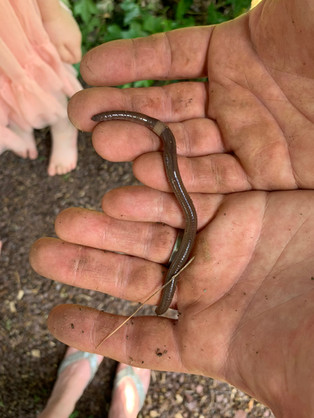Compost(ed): Learning from the Ground up
- mayokleinberg

- Feb 4, 2021
- 5 min read
Integrating compost and gardening into every day life
I often wonder what other people do— in and around their homes and businesses— in terms of composting and gardening. I guess I always thought I wasn't doing enough and everyone else was doing so much more to make an impact in the world, in their town, or their own back yards. I recently entered a proposal to lead a presentation about composting and gardening with children at a national conference. I was worried that maybe several other people had already entered similar proposals and mine wouldn't get chosen. So I called up some nature school friends. "Do you think this is just over played? Will there be too many submissions?" And the answers surprised me. "No, actually. You know, so many nature programs have a grow your own food situation, so it seems like a well thought out topic. [How many nature programs do you think also have a comprehensive composting program?] Not many!"
Here a Garden Tower Project composting/garden structure is being assembled. It can hold 54 different plants and has a central tube which is used for composting and has a compost tea/ compost collection drawer. It rotates for ideal sun collection. We used an organic potting soil, organic garden blend, and a mushroom/pine/castings blend from Canada. We started some plants from seed but picked up the others at Eagle Point Farm Stand in Trexlertown and Rodale Institute in Kutztown. We also searched for worms and added some to the beds. This year we focused on oregano, chives, garlic, anise hyssop, houndstooth, lemon balm, squash, peppers, kale, tomatoes, basil, tulsi, cilantro, pea shoots, carrots, and potatoes. There were several varieties of many of the herbs because we love to eat our colors.
"Those are wonderful and beautiful skills to learn to do and appreciate... and all kids love dirt and worms" ~Sommer, Red Fox Nature Community
So, I don't by any means consider myself an expert on this topic. It seems I always consider myself a beginner because I recognize there is always so much more to learn, about everything. But I can say that I have been doing this for a long time. Actually, I took a school gardening program at Longwood Gardens in 2010 and I loved it. If I hadn't been moving across the state that week, I would have taken Level One and Level Two. It was a week long course from 8am-2pm at the Longwood Gardens property in Kennett Square. It was a blended experience of hands-on gardening, potting, planning, discussions, field trips, exploration, and growth. I really enjoyed it and was woken up to this nature-based schooling philosophy. I would be covered in mud, immersed in nature learning, then run to my car and drive back to Philadelphia for my last set of classes which started at 5pm. Imagine, the last week of your graduate program—you have been dedicating your studies and time to complete your work and get this degree and you realize, "Hey, we never even covered this type of learning or studies." I have only now discovered the amount of NB-education centers and schools around Philadelphia that were there all along. I could have been working at any one of them during the day and attended my night classes. Luckily, I have found them and become accustomed to many of them now.
So what does this have to do with composting and gardening with children? Where do I start? What do I do? This seems like a lot of effort and money.
Gardening and composting can be as simple as a small pile in your outdoor space in which you place plant-based food scraps, shredded paper/junk mail, newspaper, and chipped outdoor plant material. You rake it, you add to it, you check on it. In the spring you gather what is ready and plant seeds in paper egg cartons in your window. You cut off the tops of carrots, radishes, turnips and regrow them in a shallow vessel of water. You cut your celery and leave the heart and put it in a glass of water and watch it sprout. After October you throw a pumpkin under a bush and realize the next year that it regrew into so many pumpkins.
Simply showing children that a seed produces a plant is an amazing first step that can segue into so many topics of exploration—so many investigations! The big picture questions and subjects that can lead to "I wonder" situations are endless:
Read some books on seeds, gardens, flowers, vegetables, compost, the food chain, life cycles and decomposition.
What happens if we don't rake all the leaves? They simply decompose on their own.
How does food make soil? What is soil? What is the difference between soil and dirt?
Use extra vegetables or fruits to make prints with paint.
Smash up flowers, leaves, roots, and herbs to make art and pigments for painting then put the left overs in the compost.
Add worms
Allow children to create and design their own garden, even just in a planter box or container inside or outside, give them full creative liberty. Maybe they can even paint the container, make a clay sculpture, and choose the seeds.
Graph and chart plant days, conditions, temperatures, and light to run experiments with older children
Take the temperature of your compost and compare and contrast two different piles / or built/constructed set ups to see what conditions create compost more quickly
These are but a few ideas for working with gardens and composts with children, or with anyone for that matter. Composting makes us more aware of how much we waste: containers, food scraps, peels, seeds, garbage. I now put out 1/2 bag of garbage a week because I extensively compost: paper junk mail, newspaper, soy-based ink paper board, food scraps, hair, dryer lint, egg shells, organic plant- or animal-based textiles that can no longer be worn, wood ash, untreated wood scraps and dust, yard clippings (excluding invasives, diseased plants, poison ivy, or other harmful or unwanted plants).
With just a few adjustments, we went from 2 bags of garbage to 1/2 bag of garbage a week. Just think if we could negotiate our waste removal price because we, in fact, make and require less waste to be removed? Think about returning everything you can to the Earth so that you can in turn, grow your own food in the soil that you made from food you once ate. We grow, we eat, we make soil, we repeat.
Stay tuned, I will be posting more on the process and types of composting set ups soon. Next week, I will begin interviewing locals and friends in the field to get their insight on nature schools, gardening, composting, recycled art, mindfulness, and Reggio-Emilio Approaches to learning. Posts will come out on our "Thirsty for Good Vibes Thursday" edition of my blog.










#composted #composting #healthysoil #gardeningwithKids #childrensgarden #visforvictorygarden #enviroEd #playoutside #raiseawildchild #sustainable #regenerative #organic